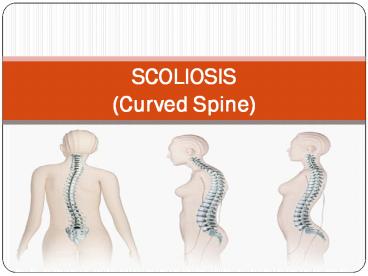Scoliosis (Curved Spine) - PowerPoint PPT Presentation
Title:
Scoliosis (Curved Spine)
Description:
Scoliosis is not a disease. It is a condition in which there is an abnormal sideways curvature in the spine. Any part of the spine can bend but the most common parts that get affected are the chest (upper back) area or the lower part of the back. The spine can curve to the right, left or sometimes both the sides. – PowerPoint PPT presentation
Number of Views:309
Title: Scoliosis (Curved Spine)
1
SCOLIOSIS(Curved Spine)
2
Introduction to Scoliosis
- Scoliosis is a sideways curving of the spine that
often gets started in childhood, when the bones
of the spine are still growing. In many cases,
the exact cause of scoliosis is unknown. - Scoliosis is detected by uneven shoulder heights,
a loss of structural balance, or a change in
posture. - Abnormal curvature of the spine (S-shaped or
C-shaped) - Condition ranges from mild to severe
- can either be inherited genetically or result
from a degenerative joint condition in the spine
3
Types of Scoliosis
- Congenital Scoliosis
- It occurs before birth while the foetus is
growing in the womb. A part of one or more
vertebrae, during the formation of the spine, may
not form properly leading to a curved spine. - Neuromuscular Scoliosis
- It is caused by poor muscle control or muscle
weakness and illnesses that affect the nerves. A
disorder called cerebral palsy may cause
neuromuscular scoliosis.
4
Continue- Types of Scoliosis
- Idiopathic Scoliosis
- When scoliosis develops in a previously straight
spine without an identifiable cause, it is known
as idiopathic scoliosis. - Degenerative Scoliosis
- It usually occurs in women above 40 years of age.
Because of the deterioration of bones, the spine
loses ability to maintain its normal shape and
begins to sag. This results into a scoliotic
curve in the spine.
5
Causes of Scoliosis
- Doctors don't know what causes the most common
type of scoliosis, although it appears to involve
hereditary factors, because the disorder tends to
run in families. Less common types of scoliosis
may be caused by - Neuromuscular conditions, such as cerebral
palsy or muscular dystrophy - Birth defects affecting the development of the
bones of the spine - Injuries to or infections of the spine
6
Symptoms of Scoliosis
- The symptoms of scoliosis may differ from one
individual to another depending upon the type,
cause and severity of the disorder. However,
there are some common symptoms, which include - The head tilted and not in line with rest of the
body - The hip appearing lower than the usual position
and tilted to one side - One shoulder blade appearing higher than the
other - Shoulders uneven in height
- An uneven neckline
- The breasts developing in unequal size, in young
girls - On bending forward, one side of the upper back
appearing higher than the other
7
Treatment of Scoliosis
- In mild cases of scoliosis a treatment is not
required. Repeated examinations every 4 to 6
months are done to determine the progress of the
curve. If the curve continues to grow, the doctor
may recommend either of the following treatment
options - PSSE is the first step to treat scoliosis and
prevent progression or bracing - Brace treatment must alwaus ne accompanied by
PSSE - A multi-professional therapeutic team, consisted
of MD, CPO and PT, id recommended to achieve the
best treatment result - PSSE programs are designed only by certified
physiotherapist































